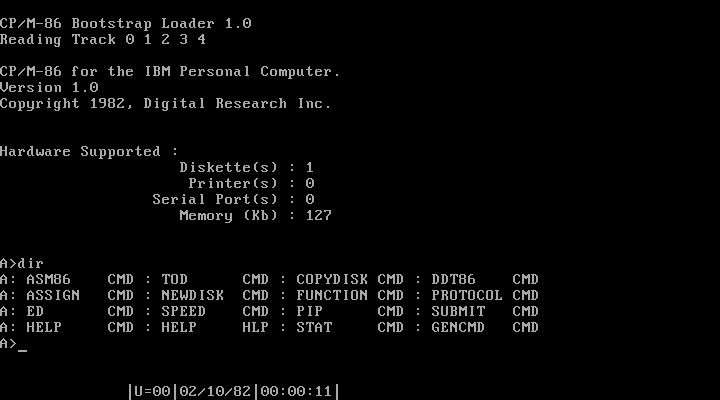|
What (ITS Utility)
What (typed as in the prompt) was a small information utility available in the Incompatible Timesharing System. It could provide information about incoming email, bus schedule on the MIT campus, executable source files or answer the user in a humorous manner. Implementation was written in the MIDAS assembly language. It can still be used on some of the ITS instances maintained across the web. The last traceable edit of the source code was by Ken L. Harrenstien on 16 May 1988. Usage examples Without arguments would print information about inbox status: *:what You don't seem to have any recent messages. :KILL E$J * With the argument bus it would print out information about the next few buses leaving from the MIT campus: *:what bus It is now 12:50 Bus 83 leaves Central Sq 13:10, 13:30, 13:45, 14:00, ... Bus 83 leaves Ringworld/Alewife 13:00, 13:20, 13:40, 13:55, ... :KILL E$J * Asked about source for NAME, responded with paths to source files corresponding to NAME: *:wha ... [...More Info...] [...Related Items...] OR: [Wikipedia] [Google] [Baidu] |
Incompatible Timesharing System
Incompatible Timesharing System (ITS) is a time-sharing operating system developed principally by the MIT Artificial Intelligence Laboratory, with help from Project MAC. The name is the jocular complement of the MIT Compatible Time-Sharing System (CTSS). ITS, and the software developed on it, were technically and culturally influential far beyond their core user community. Remote "guest" or "tourist" access was easily available via the early ARPAnet, allowing many interested parties to informally try out features of the operating system and application programs. The wide-open ITS philosophy and collaborative online community were a major influence on the hacker culture, as described in Steven Levy's book ''Hackers'', and were the direct forerunners of the free and open-source software, open-design, and Wiki movements. History ITS development was initiated in the late 1960s by those (the majority of the MIT AI Lab staff at that time) who disagreed with the direction taken by Proj ... [...More Info...] [...Related Items...] OR: [Wikipedia] [Google] [Baidu] |
Dynamic Debugging Technique
Dynamic Debugging Technique (DDT) is a series of debugger programs originally developed for Digital Equipment Corporation (DEC) hardware, initially known as DEC Debugging Tape because it was distributed on paper tape. The name is a pun on the insecticide DDT. The first version of DDT was developed at MIT for the PDP-1 computer in 1961, but newer versions on newer platforms continued to use the same name. After being ported to other vendor's platforms and changing media, the name was changed to the less DEC-centric version. Early versions of Digital Research's CP/M and CP/M-86 kept the DEC name DDT (and DDT-86 and DDT-68K) for their debugger, however, now meaning "Dynamic Debugging Tool". The CP/M DDT was later superseded by the '' Symbolic Instruction Debugger'' (SID, ZSID, SID86, and GEMSID) in DR DOS and GEM. In addition to its normal function as a debugger, DDT was also used as a top-level command shell for the Massachusetts Institute of Technology (MIT) Incompatible ... [...More Info...] [...Related Items...] OR: [Wikipedia] [Google] [Baidu] |
Massachusetts Institute Of Technology
The Massachusetts Institute of Technology (MIT) is a private land-grant research university in Cambridge, Massachusetts. Established in 1861, MIT has played a key role in the development of modern technology and science, and is one of the most prestigious and highly ranked academic institutions in the world. Founded in response to the increasing industrialization of the United States, MIT adopted a European polytechnic university model and stressed laboratory instruction in applied science and engineering. MIT is one of three private land grant universities in the United States, the others being Cornell University and Tuskegee University. The institute has an urban campus that extends more than a mile (1.6 km) alongside the Charles River, and encompasses a number of major off-campus facilities such as the MIT Lincoln Laboratory, the Bates Center, and the Haystack Observatory, as well as affiliated laboratories such as the Broad and Whitehead Institutes. , 98 ... [...More Info...] [...Related Items...] OR: [Wikipedia] [Google] [Baidu] |
Time-sharing Operating Systems
In computing, time-sharing is the sharing of a computing resource among many users at the same time by means of multiprogramming and multi-tasking.DEC Timesharing (1965), by Peter Clark, The DEC Professional, Volume 1, Number 1 Its emergence as the prominent model of computing in the 1970s represented a major technological shift in the history of computing. By allowing many users to interact concurrently with a single computer, time-sharing dramatically lowered the cost of providing computing capability, made it possible for individuals and organizations to use a computer without owning one, and promoted the interactive use of computers and the development of new interactive applications. History Batch processing The earliest computers were extremely expensive devices, and very slow in comparison to later models. Machines were typically dedicated to a particular set of tasks and operated by control panels, the operator manually entering small programs via switches in order ... [...More Info...] [...Related Items...] OR: [Wikipedia] [Google] [Baidu] |

.jpg)
